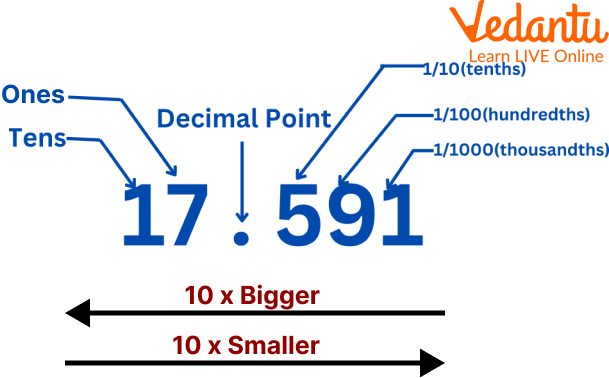




How to Round Numbers Correct to Two Decimal Places in Maths
Rounding to two decimal places is a common mathematics practice. By rounding the number off to the closest whole number, this procedure helps to make the calculation simpler. There are many uses of rounding off to two decimal places in math. Students should know how to round off numbers to two decimal places because rounding off numbers can help them get the correct answer in their calculations. They can use this technique for any number and any type of problem. This way, they will be able to understand how rounding works and how it is applied in different situations.
What is Round off?
Rounding a number means the process of making a number simpler such that its value remains close to what it was. The result obtained after rounding off a number is less accurate, but easier to use. While rounding a number, we consider the place value of digits in a number.
For Example: Round 0.439 to the nearest hundredths.
Ans: In this case, the digit to the right of the hundredths place, that is, the thousandths place is 9, which is more than 5. So, we will add 1 to the digit in the hundredths place, that is, 3 + 1 = 4, and write 0 in the digits to the right. So, 0.439 will be rounded to 0.44.
Rounding the Numbers up to 2 Decimal Places
In other words, if we are asked to round off a number to two decimal places, it means we need to round it to the nearest hundredths. Similarly, when we are asked to round off a number to one decimal place, it means we need to round it to the nearest tenths. Decimal numbers are often rounded off to make them easier to understand and use in calculations. Rounding a decimal number to two decimal places is the same as rounding it to the hundredths place, which is the second place to the right of the decimal point. For example, 2.83620364 can be rounded to two decimal places as 2.84, and 0.7035 can be rounded to two decimal places as 0.70.

Rounding off Decimals
Steps to Round Off to Two Decimal Places
Here mainly the decimal numbers have been told in this regard to the nearest hundredth or correct to two decimal places, which are like this.
Step 1: Identify the digit at the thousandths place or the third place to the right of the decimal point.
Step 2: If the thousandths place digit is greater than or equal to 5, the hundredths place digit will be increased by one. And if the thousandths place digit is less than 5, the hundredths place digit will remain unchanged.
Step 3: Ignore all the remaining digits in the decimal part of the number.

2 decimal places example
2 Decimal Places Example
Given are some 2 decimal places examples of rounding off, that explain how to round numbers to the proper second place of decimals, to the nearest hundredths:
Q 1. Round 0.9999 to two decimal places.
Ans: To round a decimal number to two decimal places, the first step is to identify the thousandths place digit which is 9 in the given number 0.9999. Since 9>5, we have to add 1 to the hundredths place digit. The digit at the hundredths place is 9, so if we add 1 to it we will get 10.
Again we have to add 1 to the tenths place keeping 0 at the hundredths place. The tenth place digit is 9, so 9 + 1 = 10.
So, again add 1 to the ones place digit keeping 0 at the tenths place. Finally, we get that 0.9999 ≈ 1.00. Therefore, by using the round to two decimal places rules, we get that 0.9999 ≈ 1.00.
Q 2 Round off, 36.978, correct up to two decimal places.
Ans: 36.978 → 36.98
When rounded to the closest hundredths, the result is more than the given decimal amount since we can see that the digit in the thousandth place is 8, which is more than 5. So, the decimal number is adjusted to 36.98.
Therefore, the result of rounding off, correct to two decimal places is 36.98.
Q 3 Round off, 7.755, correct up to two decimal places.
Ans: To round to two decimal places, we have to look at the digit at the thousandths place. The given number is 7.755. Here the thousandths place digit is 5. So, we will be adding 1 to the hundredths place digit for rounding up the value. After rounding up, the digit at the second decimal place will become 5+1, which is 6. Therefore, 7.755 ≈ 7.76.
Q 4. Evaluate square root of 3 upto 2 decimal places
Ans: The square root of a number can be calculated using the long division method.
Given: $\sqrt{3}$
Since $\sqrt{3}=1.7324$, The value up to two decimal places will be two digits after the point.
$\sqrt{3}$ value upto two decimal places is $1.73$
Practice Problems
Here are some practice problems of rounding off to two decimal places, which are as follows:
Q1. 8.514
Ans. 8.51
Q2. 89.937
Ans. 89.94
Q3. 461.631
Ans. 461.63
Q4. 4.839
Ans. 4.84
Q5. 37. 365
Ans. 37.37
Summary
Rounding to two decimal places is a common math practice. It is used to make calculations easier and more accurate. Rounding off is the most widely used practice in doing calculations. It’s used to make calculations easier and more accurate. This technique can be applied in many aspects of life, including finance, science, and engineering. In this section, we briefly discussed the concept of rounding off to two decimal places. We will also discuss how rounding affects computation and some of the practice problems, based on rounding off to two decimal places in math.
FAQs on Correct to Two Decimal Places: Meaning, Rules & Examples
1. What does it mean to correct a number to two decimal places?
To correct a number to two decimal places means to round it off so that there are only two digits remaining after the decimal point. This process simplifies a number with many decimal digits to a shorter, more manageable approximation. It is also known as rounding to the nearest hundredth. For example, the number 5.4829 becomes 5.48 when corrected to two decimal places.
2. What is the main rule for rounding a number to two decimal places?
The main rule is to look at the digit in the third decimal place (the thousandths place).
- If this digit is 5 or greater (5, 6, 7, 8, or 9), you round up. This means you add 1 to the second decimal digit.
- If this digit is less than 5 (0, 1, 2, 3, or 4), you round down. This means you keep the second decimal digit as it is.
3. Why do we look at the third decimal place when rounding to two decimal places?
We look at the third decimal place because it tells us whether the original number is closer to the rounded-up value or the rounded-down value. The second decimal place represents hundredths, and the third decimal place helps us decide which hundredth is the nearest. For example, in the number 3.147, the value is closer to 3.15 than it is to 3.14. The '7' in the third place signals this, prompting us to round up for a more accurate approximation.
4. Can you explain with an example how to round 87.9152 to two decimal places?
Certainly. To round 87.9152 to two decimal places, follow these steps:
- First, identify the digit in the second decimal place, which is 1.
- Next, look at the digit immediately to its right (the third decimal place), which is 5.
- Since the rule is to round up if this digit is 5 or greater, we add 1 to the second decimal digit (1 + 1 = 2).
- Therefore, 87.9152 corrected to two decimal places is 87.92.
5. What is the difference between rounding to two decimal places and simply truncating a number?
The key difference is how they handle the remaining digits. Rounding finds the closest value, while truncating simply cuts off the digits without considering their value. For the number 4.568:
- Rounding to two decimal places gives 4.57, because the third digit (8) is 5 or more, so we round up the second digit.
- Truncating to two decimal places gives 4.56, because it just removes all digits after the second place.
6. Where is rounding to two decimal places used in real life?
Rounding to two decimal places is extremely common in everyday situations, especially those involving money.
- Financial Calculations: All prices, bills, and bank statements are expressed with two decimal places (e.g., ₹25.50).
- Measurements: When measuring length, weight, or volume, results from calculations are often rounded for practicality. For instance, a weight of 72.348 kg might be recorded as 72.35 kg.
- Scientific Data: Scientists often round their results to a specific number of decimal places to reflect the precision of their instruments.
7. What common mistakes should I avoid when rounding numbers to two decimal places?
Students often make a few common errors when learning this topic. Be careful to avoid these:
- Rounding in stages: Do not round the fourth decimal to the third, and then the third to the second. Always look only at the third decimal place to decide the fate of the second. For example, to round 3.4849, look only at the '4', not the '9'. The correct answer is 3.48.
- Forgetting the rule for 5: Remember that a '5' in the third decimal place always means you round up.
- Truncating instead of rounding: Do not just chop off the digits. Always check the third decimal digit to decide whether to round up or keep it the same.
8. In which Maths topics is it important to give answers correct to two decimal places?
Giving answers correct to two decimal places is crucial in several Maths topics as per the CBSE curriculum, especially when dealing with irrational numbers or complex division. Key topics include:
- Mensuration: When calculating the area or circumference of a circle using Pi (π ≈ 3.14159...), the final answer is often required to be rounded.
- Square Roots: Finding the square root of non-perfect squares (e.g., √2 or √3) results in a non-terminating decimal that needs rounding.
- Percentages and Finance: Calculations involving interest, profit, loss, and discounts often result in numbers with more than two decimal places that must be rounded for monetary values.









